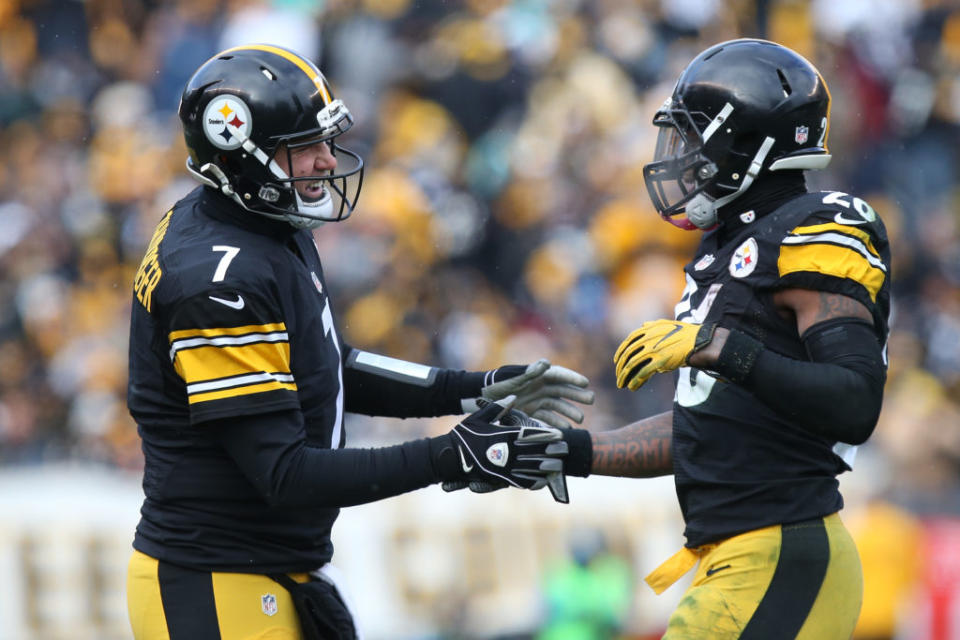Comparing Le’Veon Bell to top receiving backs

Yesterday, we broke down the top three running backs in the NFL, and how successful they are against a certain number of players in the box. Side-by-side Ezekiel Elliott may have proven to be the best runner in the most commonly faced situations. However, the case for Le’Veon Bell and David Johnson as overall backs ahead of Elliott does not stop at how they ran behind their line. These two are much greater pass catchers. While Johnson had 120 targets and Bell had 94 last season, Elliott had just 39. When looking to how valuable these two are as pass catchers, they have been compared to one another, and the other top pass catching running backs in the league. Last season 18 running backs saw 50 receiving targets. We will break down how they all fared in comparison to Johnson and Bell.
The only way to break down this stats will be per game metrics and averages per target. Bell missing time last season would skew too many stats.
Targets per game
As many would expect, Bell and Johnson lead the running backs in targets per game. In fact, they are the only two to average over seven targets per game, Bell getting 7.8 attempts and Johnson seeing 7.5 targets. Theo Riddick is the next closest at 6.4 targets, and then it falls down to James White at 5.4. Elliott only saw 2.6 targets per game. For comparison, Isaiah Crowell averaged 3.3 targets per game on a team where Duke Johnson also saw 4.6 targets per game.
Catchers per game
Bell was consistent at bringing in his targets. His 7.8 targets per game led running backs and his 6.3 receptions per game lead running backs as well. In fact, he even gains an edge on Johnson, who finished third with five receptions per game, a touch below Theo Riddick at 5.3 receptions per game. Riddick is showing he is a rarity in his own as another major drop off comes after the big three. Giovani Bernard finished fourth with 3.9 targets per game and James White finished fifth with 3.8. Elliott hauled in just 2.1 passes per game, below Crowell at 2.5, and Todd Gurley at 2.7.
Completion percentage
While Bell was extremely consistent at hauling in his targets, he still finished fourth amongst the top 18 targetted running backs in completion percentage. LeSean McCoy, Devonta Freeman, and Jerick McKinnon were more efficient, albeit on 37, 29, and 41 fewer targets than Bell. Still, while Bell did have 26 fewer targets than David Johnson, he still completed 79.8 percent of his targets compared to the 66.7 percent that Johnson hauled in. Johnson saw more than the double the number of targets of some of these players but did finish 18th out of 18 in completion percentage. One small case can be made for Elliott here in that he completed 82 percent of his targets which would have landed him third on this list.
AROUND COVER32
Around the NFL: Giants’ WR, Brandon Marshall, suddenly walks away from Boston radio interview
What’s Trending: After serving 9 years in prision, O.J. Simpson granted parole
Fantasy Focus: Who are the three most undervalued WR’s for the 2017 season
cover32 Podcast: Brandon Ray discusses the Jacksonville Jaguars with Ian Glendon
The Latest: Breaking down Steelers’ star RB, Le’Veon Bell’s contract situation
Yards per game
Johnson gets back his credit here. Some of the lack of success through the air for Johnson can be due to the fact that the team does you use him to throw the ball further down the field than other backs. Some of this can be shown by Johnson leading the league with 54.9 yards per game, higher than Bell who finished second with 51.3. Theo Riddick finishes third again, but these two sore above him with picking up yards, as he averaged just 37.1 yards per game. While Elliott finished with less than half as many yards per game, 24.2, it was still a better mark than McCoy, Gurley, McKinnon, DeMarco Murray, Ty Montgomery, T.J. Yeldon, Mark Ingram and Travaris Cadet. This is where Johnson and Bell prove so much more valuable than any other running back.
Yards per target
Yards per target is another feather in the cap of Johnson. He put up 7.3 yards per target, which was tied with Melvin Gordon for the best among the running backs with 50 targets. Gordon finished sixth among those backs in yards per game and is second to Johnson in yards per catch.
Bell was not too far behind but finished sixth with 6.6 yards per target. Elliott begins to get credit back in this department by averaging 9.3 yards per target.
At the end of the day, the debate between Bell, Elliott, and Johnson comes down to system and usage. Johnson is used down field more in the passing game, while Bell is more efficient for those easy yards in the passing game. Elliott is a player who has been efficient in the passing game, but it has been on a smaller scale. Adding in Elliott’s consistent rushing ability and these three are essentially neck and neck with small bickering points to debate as we head into the 2017 season.
The post Comparing Le’Veon Bell to top receiving backs appeared first on Cover32.


